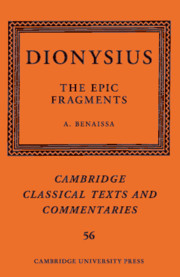Book contents
Appendix: The Fragments of the Gigantias
Published online by Cambridge University Press: 01 February 2018
Summary
This appendix presents the fragments of Dionysius’ other known poem, the Gigantias, essentially in the form and order found in Livrea's edition, but with a few corrections, new readings, and supplements proposed by Marcotte (1988), Meliadò (2014), Henry, and myself. Unlike some of the fragments of the Bassarica, those of the Gigantias are too disjointed and scrappy for one to determine confidently their contents and context. Six of the fragments are citations by Stephanus of Byzantium (one probably overlapping with fr. 14.3), while the rest are preserved by two papyri, P.Oxy. xxxvii 2815 = π3 of the second century and P.Lond.Lit. 40 = π1 of the late fourth or early fifth century, the last of which also carried the Bassarica. The poem encompassed at least three books (fr. 5). Stephanus quotes from all three. Because fr. 14.3 from P.Oxy. 2815 mentions the toponym Keladone, which according to Stephanus occurred in the first book of the Gigantias, it may be that all the fragments preserved by this papyrus are from Book 1, but this must remain uncertain. The scene in fr. 7 from P.Oxy. 2815, which relates to Heracles’ alliance with Aigimios, ought to take place after the events narrated in the fragments of P.Lond.Lit. 40 (Heracles’ sack of Kos and the gigantomachy).
Two of the places cited by Stephanus from this poem are in Thessaly (Dotion, Nesson) and one is in the Chalkidike peninsula (Titon). Their exact connection to the gigantomachy is uncertain, apart from the fact that they are relatively close to the site of the battle in Phlegre (cf. fr. 52v.4), which was commonly identified with the Pallene peninsula in antiquity (across the Thermaic Gulf from Thessaly). The Thessalian localities might alternatively be connected to Heracles’ alliance with Aigimios against the Lapiths, which is related in fr. 7 (see below). The other two fragments from Stephanus, whose original context is unknown, name a region of Epirus (Orestis) and a town in Locris (Keladone).
- Type
- Chapter
- Information
- Dionysius: The Epic Fragments , pp. 225 - 289Publisher: Cambridge University PressPrint publication year: 2018



